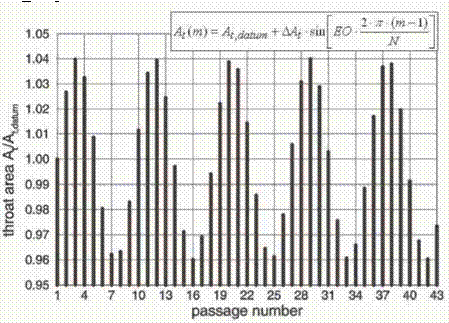Experimental data and boundary conditions Experiments
High quality experiments were set up and performed at the cold fbw wind tunnel for rotating cascades (RGG) at DLR in Gottingen, Germany. The aim of the experiments was to simulate the effects of Low Engine Order excitation in a high pressure turbine stage. Therefore, the stator was modified to provide well defined configurations of distorted stators. One modification comprised a 5th engine order variation of the stator pitch, which is shown in Fig. 2. In a similar way, a 7th engine order variation was established.
The stator exit flow was measured first without and then with the rotor behind the stator. Table 1 presents data that was measured to provide and evaluate boundary conditions for CFD simulations. Additionally, stator inlet ft>w mea-
|
Table 1. Overview of available measured data.
|
 |
surements were available including an assessment of the hub and tip end wall boundary layer status in front of the stator, see [7]. The operating point under consideration leads to transonic fbw both in the stator and in the rotor, and a stator trailing edge shock contributes significantly to the stator exit fbw. The
effective exit Mach number is averaged to slightly above one, which makes the analysis relatively sensitive regarding the resulting rotor excitation. The averaged rotor exit fbw Mach number is well below one, but inside the passage, local transonic regions are expected. The rotational speed is adjusted such that a resonance condition, as computed in a structural analysis of the rotor, is met. Planned experiments will assess the unsteady pressure and the vibration characteristics of the rotor blades under these forced response conditions. However, such data is not available for the present evaluation of the numerical results.











